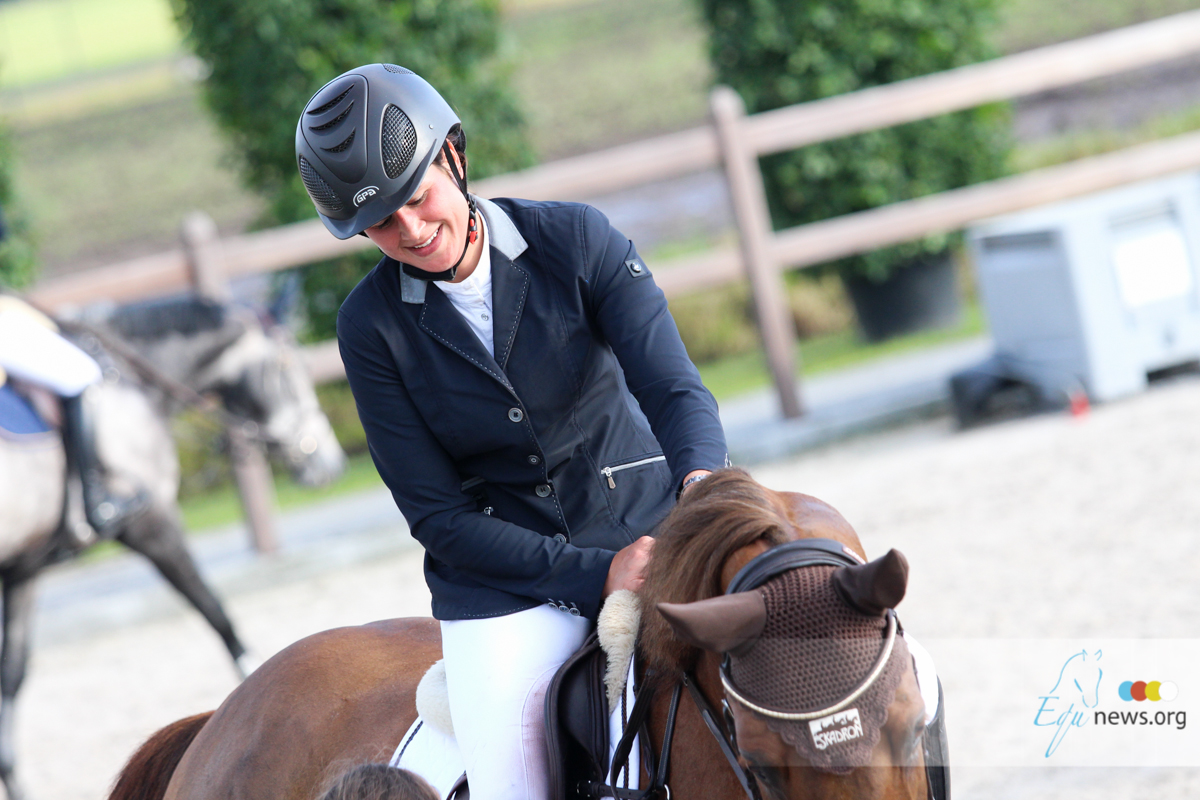In this last episode of the perfect warm-up we're ready to focus on the actual jumping warm-up... So here are Steve & Jenni: Progress to a Vertical Next, change the crossrail to a vertical set two or three holes lower than competition height. The goal is still to encourage the full range of motion in your horse’s shoulders. If that’s already feeling really good at this point, you can start with a slightly higher vertical. Roll the ground rails in to about 3 inches from the base of the jump. This will invite him to get closer to the jump on takeoff and possibly rub a rail. Approach the vertical with a little more pace than you had over the crossrail, daring him to snap his legs up more quickly in the air. Continue to test his responsiveness after the jump with frequent changes of pace, turns, lateral work, etc. If he tends to get “bullying” in the approach—pulling on the reins and getting underneath the fence (too close to it on takeoff to produce his best jump)—roll the ground rails back out to about 6 inches to encourage him to jump better. For extremely bullyish horses, you may need to roll it out to 9 or 12 inches. If your horse drops his hind end a little in the air (a habit your ground person might notice or that would be evident if he frequently knocks down rails in the ring with his hind legs), place a rail on the ground either 9 or 18 feet away from the jump on the landing side. This will catch his attention as he lands and remind him to be more careful with his hind feet. Note: For all gymnastic exercises like this one, adjust the distances to make them comfortable for your horse’s natural stride. Don’t make them so short or long that he might run into trouble. The goal is to show him what he can do, not what he can’t. Each time you jump the vertical, increase the height by one or two holes, until you get to show height. Repeating the same height over and over again wastes your horse’s jumping efforts. Only do it after a very bad effort or because you’ve reached the maximum height. Otherwise, move on to the next height or exercise. (After most moderately bad efforts, such as a missed distance or knockdown, both you and your horse will usually know why you made the mistake and won’t need repetition to learn from it.) Now is the time to begin fine-tuning your warm-up. Create exercises to address the questions on course that you think will be most challenging for you and your horse. Here are some sample exercises: Exercise 1 Challenge: Collecting for a short distance. For example, if a vertical is followed by four or five short strides to an oxer, the sooner you can collect after landing from the vertical, the more forward you’ll be able to ride to the oxer. Solution: Place a rail on the ground 18 to 21 feet after the vertical, again, adjusting the distance to produce a comfortable one stride. This will naturally encourage him to shorten in the first stride after landing. (Once he’s backing himself off from the rail, you may be able to shorten the distance a little more to ask for additional collection.). Use the rail as a reminder to get yourself immediately back into position, too. Exercise 2 Challenge: Hot horse who runs off on the landing side of the jumps. Solution: Set a rail 32 feet (two strides, adjusted for your horse’s natural stride) after your warm-up vertical. When he lands, stretch your body upward and let the rail do the work. After jumping through this a few times, he’ll figure out that he needs to slow himself down on landing. Exercise 3 Challenge: A longer than usual distance in a combination. Because they see so many tight combination distances, horses generally expect to jump into one and have to “back up” (collect the stride) right away. When suddenly faced with a longer distance, they can sometimes get into trouble and arrive too far away from the “out” jump. Solution: Set a rail 24 feet after your warm-up vertical. This will encourage him to open up his stride on landing. Exercise 4 Challenge: A bending line in the direction that your horse has trouble with—for example, he tends to bulge his shoulder to the outside. Solution: Place a rail three to four strides away from the jump, then ride a curved track from the jump to one side of the rail. So, for example, if you’re practicing for a line that bends to the left, aim to cross the left-hand side of the rail. Once your horse is using his shoulders well over the vertical, give him another breather and take a moment to check your equipment—galloping boots, bit, spurs, etc. Build an Oxer Next, move on to a ramped oxer. If you can, build it so that you’ll jump it first in the direction that your horse goes best. Leave the vertical as is for the back rail, then add a second set of standards in front of it, so the width of the oxer is about half the width of the widest fence on course. Set the front rail about two holes lower than the back rail and place a ground rail about 3 inches in front of the jump. Approach this oxer at ring pace or even a little faster than ring pace. Open up your horse’s step on the long side of the arena, letting him run away from you and even get a little out of balance. (This will produce the power you want to collect in front of the jump—and will test his rideability.) As you make your turn to the oxer, start to ask for balance and control again, so that he arrives three or four strides away from the jump with the correct amount of speed and impulsion for the size of the jump. If you can, reverse the ramp jump (lower the back rail and raise the front rail) so that you can jump it from the other direction. Next, if your horse’s hind legs feel loose and free (you’re feeling that extra kick in the air) and he’s jumping across the oxer easily, raise the front rail to one hole lower than the back rail and widen the oxer to the maximum height and width on course. (If your horse is young, it may not be necessary to jump the maximum height in warm-up, which might scare him. Courses are designed to build a horse’s confidence as he progresses. So, for example, if you’re jumping in the 1.25-meter class, it’s fine to warm-up over just a 1.20-meter oxer.) If your horse makes a particularly impressive effort over the oxer, consider lowering the height for your next attempt. This will reassure him that the jumps won’t always be so big. For some horses, giving such a great effort can be a little discouraging unless you immediately follow it with a confidence builder. Then take a break and evaluate how you and your horse are feeling. Do you want to jump higher or wider? This might help improve a lazy hind end. Do you want to try for a rub—riding to the oxer with plenty of pace and soft hands? Do you need to widen the ground rail to improve his technique in the air? Depending on your personal timing preference, plan to jump your last one or two jumps at about the time the rider before you is midway through the course. We usually go back to a vertical at the end of the warm-up—unless that particular horse needs more encouragement to jump across his fences or sometimes when the course starts with an oxer. A final vertical reminds the horse to be a little more collected and to round up his arc in the air, in case he got a little flat over the oxer. Some people like to go to the ring on a rub, but we’d rather end the warm-up on a confident effort so the horse goes to the ring feeling like he’s jumping as well as he possibly can. Now your challenge is to bring your warm-up into the ring. From your last warm-up jump to the moment you enter the ring, keep your mental focus. Now is not the time to hang out at the in-gate and chat. Separate yourself from other riders and your entourage and either visualize the course one more time or recite it to your ground person. Stay 100 percent in your competitive groove.



